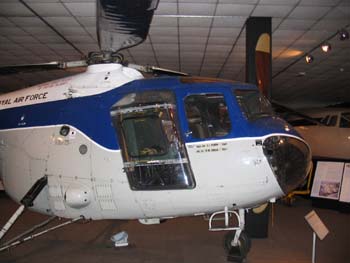- Bristol Sycamore
infobox Aircraft
name = Type 171 Sycamore
type = Rescue and Anti-Submarine Helicopter
manufacturer =Bristol Aeroplane Company 
caption =
designer =Raoul Hafner
first flight = 27 July 1947
introduced = 1953
retired =
status =
primary user =Royal Air Force
more users =Royal Australian Navy German Army
produced = 1947 - 1955
number built = 180
unit cost =
developed from =
variants with their own articles =The Bristol Type 171 Sycamore was the first British designed
helicopter to fly and serve with theRoyal Air Force . Created by theBristol Aeroplane Company , it was used forsearch and rescue andanti-submarine warfare .Design and development
Bristol set up its Helicopter Department in after the Allied invasion of Europe in 1944, when engineers from the Airborne Forces Experimental Establishment at
Beaulieu became available. The AFEE had been working on the development of helicopter designs under helicopter pioneerRaoul Hafner , but the success of Horsa and Hamilcar gliders duringOperation Overlord led to helicopter research being given a priority at AFEE.The design of the Sycamore commenced in June 1944, and extended over more than two years, with especial emphasis being given to the endurance of the mechanical components. The maiden flight took place on 27 July 1947, with the prototype VL958 powered by a 450 hp
Pratt and Whitney Wasp Junior (there being no suitable engine in the Bristol range). The prototype Sycamore Mk.2 was completed in the summer of 1948, powered by a 550 hpAlvis Leonides ; this became the standard engine for all subsequent Sycamore production.Versions of the Sycamore up to and including the Mk.3A kept to the standard two-seat aircraft layout of having the pilot in the left-hand seat and co-pilot in the right. The main production, the Mk.4, switched to the American standard practice of having the pilot's seat on the right. There were also a number of other developments from earlier versions, such as a four-door design, that were standardized for the Mk.4. This version entered RAF service as the H.R.14.
Civil versions did not use the name Sycamore, and were known simply as Bristol Type 171.
Operational history
The Sycamore H.R.14 entered service with 275 Squadron of the RAF in April 1953, and went on to serve with nine
squadron s in total. It was used during theMalayan Emergency (1948-1960) for deploying Army foot patrols into the jungle.A total of 50 Sycamores were delivered to the German Federal Government, and three to the Belgian Government.
The Sycamore also has the distinction of being the second helicopter type to be used by the
Australian Defence Force , when seven were delivered to theRoyal Australian Navy .Variants
Type 171
;Mk 1: Prototype; two built. ;Mk 2: Second prototype; one built. ;Mk 3: Production model with five-seats in a widened fuselages and a shortened nose to improve visibility. 15 built. ;Mk 3A: Civilian version with additional freight hold, 2 built for
BEA .;Mk 4: The main production model and the military version called Sycamore with a more powerful engine.ycamore
;Sycamore HC10: (=Mk.3) 1 built for evaluation by the Army Air Corps as an air
ambulance .;Sycamore HC11: (=Mk.3) 4 built for evaluation by the Army Air Corps, as communications aircraft.;Sycamore HR12: (=Mk.3A) 4 built for the RAF for evaluation as search and rescue aircraft.;Sycamore HR13: (=Mk.3A) 2 built with rescue winches for the RAF for evaluation as search and rescue aircraft. ;Sycamore HR14: (=Mk.4) 85 built for the RAF, as search and rescue aircraft.;Sycamore Mk 14: 3 built for theBelgian Air Force , for use in theBelgian Congo .;Sycamore Mk 50: 3 built for theRoyal Australian Navy , for search and rescue, and plane guard duties.;Sycamore HC51: 7 built for the Royal Australian Navy, for search and rescue, and plane guard duties.;Sycamore Mk 52: 50 built for the German Army and Navy.Operators
Civil operators
Military operators
;AUS
*Royal Australian Air Force
*Royal Australian Navy
**723 Squadron RAN
** 724 squadron RAN;BEL
*Belgian Air Force ; DEU
*German Army
*German Navy ; UK
*Royal Air Force
**No. 32 Squadron RAF
**No. 103 Squadron RAF
**No. 110 Squadron RAF
**No. 115 Squadron RAF
**No. 118 Squadron RAF
**No. 155 Squadron RAF
**No. 194 Squadron RAF
**No. 225 Squadron RAF
**No. 228 Squadron RAF
**No. 275 Squadron RAF
**No. 284 Squadron RAF
**No. 651 Squadron RAF
**No. 657 Squadron RAF pecifications (Mk.4 / HR14)
aircraft specifications
plane or copter?=copter
jet or prop?=prop
ref=
crew=Two
capacity=accommodation for three passengers
payload main=1,000 lb
payload alt=454 kg
length main= 61 ft 1¼ in
length alt=18.62 m
span main=48 ft 7 in
span alt=14.8 m
span sweep=
height main=13 ft 10.6 in
height alt=4.23 m
area main=
area alt=
airfoil=
empty weight main=3,810 lb
empty weight alt= 1,728 kg
loaded weight main= 5,600 lb
loaded weight alt= 2,540 kg
useful load main=
useful load alt=
max takeoff weight main=
max takeoff weight alt=
more general=engine (prop)=
Alvis Leonides
type of prop=piston engine
number of props=1
power main= 550 hp
power alt=410 kW
power original=max speed main= 132 mph
max speed alt= 212 km/h
cruise speed main=
cruise speed alt=
stall speed main=
stall speed alt=
never exceed speed main=
never exceed speed alt=
range main= 330 miles
range alt=531 km
ceiling main=
ceiling alt=
climb rate main=
climb rate alt=
loading main=
loading alt=
thrust/weight=
power/mass main=
power/mass alt=
more performance=
* Endurance: 3½ hours
armament=
avionics=ee also
aircontent
similar aircraft=
*H-5 Dragonfly
*Westland Dragonfly
lists=
*List of aircraft of the RAF References
* cite book
last=Bowyer
first=Chaz
authorlink=Chaz Bowyer
title=The Encyclopedia of British Military Aircraft
publisher=Bison Books Limited
id=ISBN 0-86124-258-0
* cite book
last=Barnes
first=C. H.
year=1964
title=Bristol aircraft since 1910
publisher=Putnam
id=ISBN 0-85177-823-2
*External links
* [http://www.rafmuseum.org.uk/bristol-sycamore-hr14.htm RAF Museum page] on the Bristol Sycamore
* [http://www.britishaircraft.co.uk/aircraftpage.php?ID=176 British Aircraft Directory page] on the Bristol Sycamore
* [http://www.helis.com/database/go/bristol_sycamore.php helis.com pages] on the Bristol Sycamore
Wikimedia Foundation. 2010.
